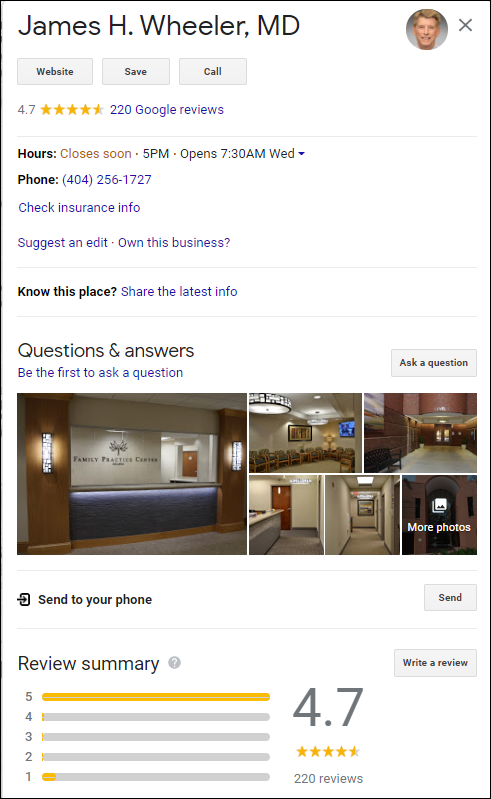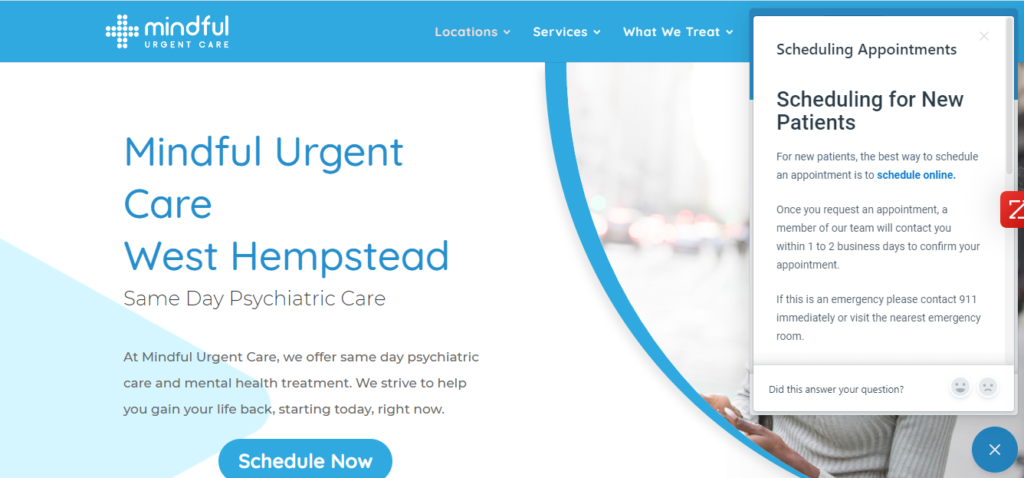These days, much of the patient experience begins and ends online. This is especially true in light of the ways digital healthcare has evolved, including online appointment scheduling, patient portals, and telehealth. As a result, patients expect low-friction digital experiences across the board. Moreover, patients consider digital channels as essential parts of their healthcare decision-making processes. In competitive healthcare markets, patient experience can be how you distinguish your brand, build a strong reputation, and get more referrals. This article shares a few ways your digital marketing team can help improve the patient experience by removing barriers, easing frustrations, and making it easy for patients to get the care they need.
Table of Contents
- 1. Optimize Your Website for Mobile
- 2. Create a Great Google My Business (GMB) Listing
- 3. Build Out a More Robust Website
- 4. Offer Multiple Ways to Schedule an Appointment
- 5. Send Automated Reminders
- 6. Educate Through Content
- 7. Consider Deploying a Chatbot
- Final Thought: Marketing Needs to Listen to Patients
1. Optimize Your Website for Mobile
In Healthcare Marketing for a Mobile-First World, we wrote at length about the opportunity cost of failing to prioritize mobile experiences. As some of the data we shared shows, you need to build website experiences with exceptional mobile user experience (UX); otherwise, people won’t use your website.
When we say optimize your site for mobile, we mean the whole kit and kaboodle. That means mobile-friendly code, navigation, and design from top-to-bottom—on each page, interaction, process, form, video, portal, and so on. For larger websites or multi-location healthcare entities, this can be a time- and cost-intensive undertaking. However, the long-term cost of failing to meet new consumer demand for mobile-optimized experiences is too steep to risk.
Step one? Take your site for a spin on your own mobile device. Put yourself in the shoes of a patient. I suspect it won’t be long before you identify where mobile users might be getting hung up.
2. Create a Great Google My Business (GMB) Listing
“Googling stuff” might sound like a silly phrase, but it’s often the first step that healthcare consumers take when seeking a provider online. One of the things those consumers will likely come across is a GMB listing. A GMB listing is essentially a business profile, which can include contact information, site links, photos, reviews, and so on. The more complete your listing, the better, as these listings are often embedded in Google Search experiences.
Here’s a look at a well-optimized Google My Business listing:

Your GMB profile is often the first thing patients find when they search for you. Your job is to ensure that healthcare consumers—new and returning—can find everything they need from you. Don’t make them hunt for information! Here are a few tips from our recent blog post, How to Optimize Your Google My Business Listing:
- Check to see if you already have listings you can work with
- Establish a Google account and Google My Business profile for each of your locations
- Optimize your listing by completing as much information as possible, including site links, service descriptions, photos and videos, promotions, and contact information
- Regularly revisit, revise, and update your listing with new posts, photos, etc.
- Respond to reviews both positive and negative
3. Build Out a More Robust Website
Your website is more than a marketing tool. It’s an opportunity to constantly create value for your new and prospective customers/patients. Think about the kinds of needs, questions, and objections that healthcare consumers have within your specific niche. What information, for instance, does a person considering cosmetic surgery need to know? What kind of information will help someone living with a particular condition improve their quality of life?
Your website content, including dedicated pages, blog posts, video content, testimonials, should offer detailed information on conditions, services, etc. Not only do patients want this, so does Google! Publishing authoritative, well-structured website content can indeed improve both patient experience and SEO simultaneously.
For more tips on how to build out a robust site, read Your Website Structure and SEO: A Primer.
4. Offer Multiple Ways to Schedule an Appointment
The first step in getting more patients to walk through your doors is to let them know you want them to contact you and schedule an appointment. But this is an opportunity to go beyond simply listing your phone number on your website. Remember that a lot of people prefer not to call healthcare providers at all.

Instead, incorporate all of your methods of contact throughout your website, GMB listing, and so on. Here are some ideas on how to do so:
- Click-to-call or click-to-text phone number
- Click-to-email email address
- Traditional contact form
- Links to social media channels
- A dedicated contact page with all methods of contact listed
- Easy navigation to your patient portal for direct communication with a physician
Naturally, the options you present for contact and appointment scheduling ought to follow the principles of mobile optimization and mobile UX.
5. Send Automated Reminders
I’ll be honest: I forget my dentist appointments all the time. Who can remember an appointment they made six months ago!? My saving grace is nearly always the automated reminders my provider sends me a couple of days in advance of my appointment.
It’s funny how big a win it can be just to remind patients to show up for their appointments. When you make that effort, you show patients that you’re committed to helping them get the care they need and that you, as a provider, bear some of that responsibility.
Lately, the SMS text message has become an effective way to send appointment reminders, as the vast majority of healthcare consumers use smartphones. However, emails and phone calls can work as well. The key is to develop automated cadences in advance of the appointment. For example, you can send a text or email seven days and three days in advance, then call the patient the day before.
You can also send reminders for special instructions too. For example, maybe a patient needs to fast in advance of their procedure or stop certain medications. Sending a detailed reminder that includes this information is yet another way to potentially improve patient outcomes.
6. Educate Through Content
When building out your site content, remember this mantra: patients first; appeasing the Google gods second. Why? Because the former now inherently supports the latter thanks to Google’s E-A-T and YMYL updates. So, how do you publish expert, authoritative, and trustworthy content that helps people make better decisions about their healthcare?
Educate your healthcare consumers by drawing on your own experience and training. We recommend mapping content to specific needs across the patient journey. Let’s take plastic surgery as an example. Early in this journey, patients are likely addressing objections and fears, such as cost, negative outcomes, and even stigma. As a plastic surgery practice, you might consider publishing an eBook or digital guide to help patients make a more informed decision (“Plastic Surgery: Is it the Right Choice for Me?”).
Sticking with the plastic surgery example, you might publish different educational content to address the needs of a patient that’s further along the journey. We’ve seen plastic surgery practices produce short, engaging video clips in which the surgeons themselves walk the patient through a procedure, including preparation, duration, and other post-op details. Testimonials work too.
Regardless of the healthcare space, the key is to become a trusted resource by consistently putting out authoritative information that helps people make better decisions (not just selling your services). If you can build out this quality of content for each stage of the patient journey, you’ll be well on your way to an improved patient experience.
7. Consider Deploying a Chatbot
In our recent blog post, How Chatbots Can Improve the Patient Experience, we took a close look at how chatbots are being used in healthcare. There’s no question that chatbots have the potential to make life easier for patients by providing timely communication and information without the need for human intervention. As they say, no one wants to call customer support if they don’t have to.

That said, poorly constructed chatbot solutions that are rushed to market can have the opposite effect on patient experience. Again, many of the principles we’ve already mentioned in the context of content, websites, and patient journey apply to chatbots. Here are some of the core tenets of a well-designed chatbot:
- Capable of understanding natural language queries
- Built on “playbooks” mapped to the most common patient queries
- Linked to an extensive content database for easy answer retrieval
- Free of “dead-ends” (if need be, the chatbot can hand the interaction off to a live agent)
- Backed by analytics that help reveal sticking points, inefficient experiences, and content gaps
Final Thought: Marketing Needs to Listen to Patients
Yes, healthcare marketers can help improve the patient experience. It’s not just selling, clicks, traffic, and conversions! Indeed, healthcare marketers often have the best tools and tactics for capturing patient insights. In the end, it’s the teams that not only listen to these insights but adapt their patient journeys accordingly that win.
So I’ll leave you with this final imperative: do what you can to learn what your patients care about most. That might mean directly asking for feedback in the form of surveys (CSAT, for example) or reviews. It might mean monitoring digital channels for insights, including Reddit, GMB reviews, Facebook pages, and so on. Finally, you might consider reviewing call lots using conversational analysis tools to connect the dots on where your patient experience could use a boost.
The point is to not only listen but to use that information to guide your marketing efforts. Share that information with your internal teams, including operations, to get aligned around putting patient experience first.
You’ll know it’s working when your patients keep coming back.

